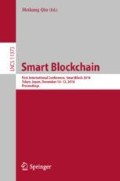Abstract
Distributed Ledger Technology (DLT) like Blockchain Technology (BCT) enables the development of trust-free P2P networks, consisting of nodes that process and propagate transactions in form of messages. Trust into other nodes and/or messages is replaced by trust into the protocols that are governing the network; most notably the message signature and consensus protocols. Depending on the chosen consensus protocols, resilience towards malicious/faulty nodes and messages ranges between \( {\raise0.7ex\hbox{$1$} \!\mathord{\left/ {\vphantom {1 3}}\right.\kern-0pt} \!\lower0.7ex\hbox{$3$}}\,\text{and}\,{\raise0.7ex\hbox{$1$} \!\mathord{\left/ {\vphantom {1 2}}\right.\kern-0pt} \!\lower0.7ex\hbox{$2$}} - 1 \) of all nodes. However, an often overlooked aspect within the resilience/security aspects of DLT networks is that they tend to interact with other components that are often less resilient e.g. clients/wallets. This, in turn, allows attackers to issue forged transactions that are formally correct. This paper focuses on detecting and containing such transaction using metadata and event propagation.
Access this chapter
Tax calculation will be finalised at checkout
Purchases are for personal use only
References
Eyal, I., Sirer, E.G.: Majority is not enough: Bitcoin mining is vulnerable. Commun. ACM 61(7), 95–102 (2018)
Heilman, E., Kendler, A., Zohar, A., Goldberg, S.: Eclipse attacks on Bitcoin’s peer-to-peer network. In: USENIX Security Symposium, pp. 129–144 (2015)
Dorri, A., Kanhere, S.S., Jurdak, R., Gauravaram, P.: Blockchain for IoT security and privacy: the case study of a smart home. In: 2017 IEEE International Conference on Pervasive Computing and Communications Workshops (PerCom Workshops), pp. 618–623. IEEE (2017)
Man-in-the-middle attacks on wallets. http://news.bitcoin.com/ledger-addresses-man-in-the-middle-attack-that-threatens-millions-of-hardware-wallets/
Chandola, V., Banerjee, A., Kumar, V.: Anomaly detection: a survey. ACM Comput. Surv. (CSUR) 41(3), 15 (2009)
Hernández-Ramos, J.L., Jara, A.J., Marın, L., Skarmeta, A.F.: Distributed capability-based access control for the internet of things. J. Internet Serv. Inf. Secur. (JISIS) 3(3/4), 1–16 (2013)
Chainalyis. https://www.chainalysis.com/
Debreceny, R.S., Gray, G.L.: Data mining journal entries for fraud detection: an exploratory study. Int. J. Account. Inf. Syst. 11(3), 157–181 (2010)
Lane, T., Brodley, C.E.: An application of machine learning to anomaly detection. In: Proceedings of the 20th National Information Systems Security Conference, vol. 377, pp. 366–380, Baltimore, USA (1997)
Valdes, A., Skinner, K.: Adaptive, model-based monitoring for cyber attack detection. In: Debar, H., Mé, L., Wu, S.F. (eds.) RAID 2000. LNCS, vol. 1907, pp. 80–93. Springer, Heidelberg (2000). https://doi.org/10.1007/3-540-39945-3_6
Kosba, A.E., et al.: How to use SNARKs in universally composable protocols. IACR Cryptol. ePrint Arch. 2015, 1093 (2015)
Christidis, K., Devetsikiotis, M.: Blockchains and smart contracts for the Internet of Things. IEEE Access 4, 2292–2303 (2016)
Ouaddah, A., Abou Elkalam, A., Ait Ouahman, A.: FairAccess: a new Blockchain-based access control framework for the Internet of Things. Security and Communication Networks 9(18), 5943–5964 (2016)
Ouaddah, A., Elkalam, A.A., Ouahman, A.A.: Towards a novel privacy-preserving access control model based on blockchain technology in IoT. In: Rocha, Á., Serrhini, M., Felgueiras, C. (eds.) Europe and MENA Cooperation Advances in Information and Communication Technologies. Advances in Intelligent Systems and Computing, vol. 520. Springer, Cham (2017). https://doi.org/10.1007/978-3-319-46568-5_53
Faisal, T., Courtois, N., Serguieva, A.: The evolution of embedding metadata in blockchain transactions. arXiv preprint arXiv:1806.06738 (2018)
Papadopoulos, G.A., Arbab, F.: Coordination models and languages. In: Advances in computers, vol. 46, pp. 329–400. Elsevier (1998)
Kephart, J.O., Chess, D.M.: The vision of autonomic computing. Computer 1, 41–50 (2003)
Murch, R.: Autonomic Computing. IBM Press (2004)
Huebscher, M.C., McCann, J.A.: A survey of autonomic computing—degrees, models, and applications. ACM Comput. Surv. (CSUR) 40(3), 7 (2008)
Nygate, Y.A.: Event correlation using rule and object based techniques. In: Sethi, A.S., Raynaud, Y., Faure-Vincent, F. (eds.) Integrated Network Management IV. Springer, Boston (1995). https://doi.org/10.1007/978-0-387-34890-2_25
Buchmann, A., Koldehofe, B.: Complex event processing. IT-Information Technology Methoden und innovative Anwendungen der Informatik und Informationstechnik 51(5), 241–242 (2009)
Deters, R.: Case-based diagnosis of multiple faults. In: Veloso, M., Aamodt, A. (eds.) ICCBR 1995. LNCS, vol. 1010, pp. 411–420. Springer, Heidelberg (1995). https://doi.org/10.1007/3-540-60598-3_37
Fadhil, M., Owen, G., Adda, M.: Bitcoin network measurements for simulation validation and parameterization. In: 11th International Network Conference, INC 2016. University of Plymouth (2016)
Maymounkov, P., Mazières, D.: Kademlia: a peer-to-peer information system based on the XOR metric. In: Druschel, P., Kaashoek, F., Rowstron, A. (eds.) IPTPS 2002. LNCS, vol. 2429, pp. 53–65. Springer, Heidelberg (2002). https://doi.org/10.1007/3-540-45748-8_5
Mahalle, P.N., Anggorojati, B., Prasad, N.R., Prasad, R.: Identity authentication and capability based access control (IACAC) for the internet of things. J. Cyber Secur. Mobil. 1(4), 309–348 (2013)
Author information
Authors and Affiliations
Corresponding author
Editor information
Editors and Affiliations
Rights and permissions
Copyright information
© 2018 Springer Nature Switzerland AG
About this paper
Cite this paper
Deters, R. (2018). How to Detect and Contain Suspicious Transactions in Distributed Ledgers. In: Qiu, M. (eds) Smart Blockchain. SmartBlock 2018. Lecture Notes in Computer Science(), vol 11373. Springer, Cham. https://doi.org/10.1007/978-3-030-05764-0_16
Download citation
DOI: https://doi.org/10.1007/978-3-030-05764-0_16
Published:
Publisher Name: Springer, Cham
Print ISBN: 978-3-030-05763-3
Online ISBN: 978-3-030-05764-0
eBook Packages: Computer ScienceComputer Science (R0)

